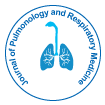Understanding Pulmonary Edema: Mechanisms, Diagnosis, and Treatment Approaches
Received Date: Dec 02, 2024 / Published Date: Dec 31, 2024
Abstract
Pulmonary edema (PE) is a condition characterized by the accumulation of excess fluid in the lungs, impairing gas exchange and leading to respiratory failure. It can be classified as either cardiogenic or non-cardiogenic, with various underlying mechanisms such as left-sided heart failure, acute respiratory distress syndrome (ARDS), and high-altitude pulmonary edema (HAPE). The clinical presentation typically includes dyspnea, orthopnea, and hypoxemia, and diagnosis is primarily based on clinical features, imaging, and laboratory tests, such as chest X-ray, echocardiography, and arterial blood gas analysis. Early identification and prompt intervention are critical in preventing severe complications. Treatment strategies depend on the underlying cause, and may include pharmacological approaches like diuretics, vasodilators, and positive pressure ventilation. Additionally, supportive measures like oxygen therapy and mechanical ventilation are employed to manage acute episodes. Advances in therapeutic protocols and early management have significantly improved patient outcomes. This review explores the mechanisms, diagnostic methods, and treatment approaches for pulmonary edema, highlighting areas of ongoing research and clinical challenges.
Citation: Huang Y (2024) Understanding Pulmonary Edema: Mechanisms, Diagnosis, and Treatment Approaches. J Pulm Res Dis 8: 235. Doi: 10.4172/jprd.1000235
Copyright: © 2024 Huang Y. This is an open-access article distributed under the terms of the Creative Commons Attribution License, which permits unrestricted use, distribution, and reproduction in any medium, provided the original author and source are credited.
